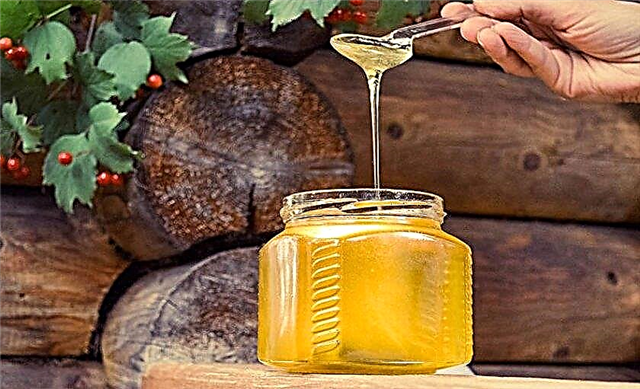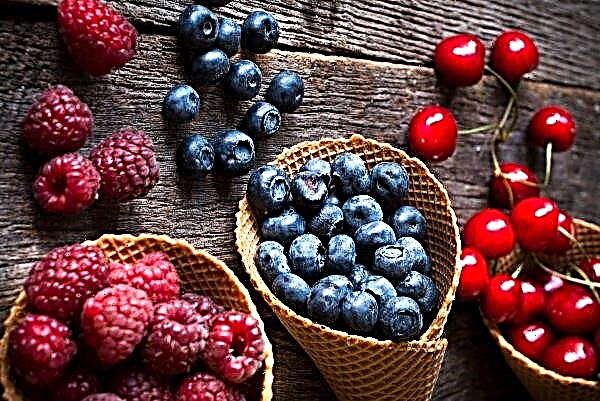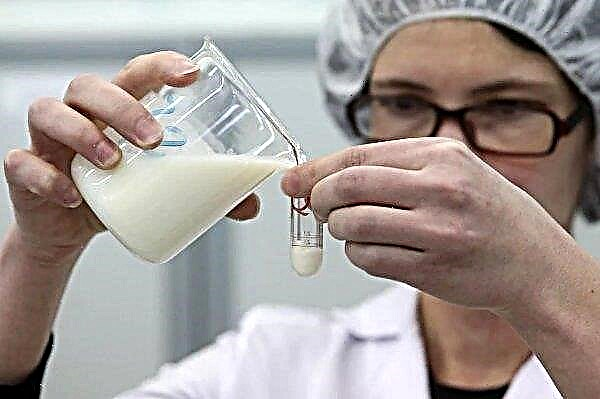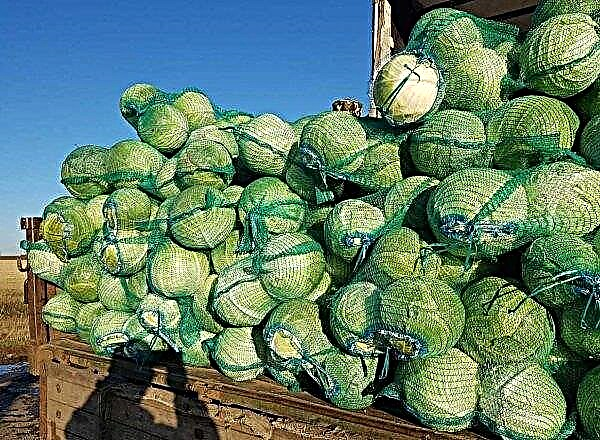Honey is not only tasty, but also a healthy treat. And if the most famous is considered the well-known linden or buckwheat, then little is known about safflower honey. The article describes the features, benefits and harms of not only this type of honey, but also the plant from which nectar is obtained.
Description of the features of safflower honey
Honey from safflower mead is rather difficult to obtain, because:
- the plant blooms only a short period of time;
- the flower contains nectar in small quantities;
- collection of nectar depends on weather conditions and does not occur annually;
- flower nectar is produced at +30 ... + 35 ° C, which is not typical for other honey plants;
- monoflora safflower honey is an extremely rare product, since this plant is planted together with other honey plants.

Composition and calorie content
Safflower nectar, like any other type of bee collection, is a very tasty and medicinal product enriched with vitamins and minerals.
The healing properties help fight various diseases and maintain a balance of nutrients, and the composition of the product gives positive results in the treatment and strengthening of the body's defenses.
Important! Consumption rates (daily): for adults — 4 tbsp. l., for children over 3 years old - 1 tbsp. l
Having a high calorie content, the beekeeping product has in its chemical composition a huge amount of rare elements and vitamins, so necessary for the life of the body.
Below is the energy value and composition of the elements per 100 g of product and a percentage of the daily intake for an adult (in brackets):
- calorie content - 300 kcal (22.4%);
- proteins - 1 g (1.22%);
- fats - 0 g;
- carbohydrates - 79 g (61.72%);
- organic acids - 1.2 g;
- water - 17.4 g;
- starch - 5.5 g;
- calcium Ca - 14 mg;
- magnesium Mg - 3 mg;
- potassium K - 36 mg;
- Phosphorus P - 18 mg.
- Fe iron - 0.8 mg;
- PP 0.2 mg
- B1 (thiamine) - 0.01 mg;
- B2 (riboflavin) - 0.03 mg;
- PP (niacin equivalent) - 0.8 mg.

The amount of protein (plant and animal) in the composition is negligible. Carbohydrates in the composition are represented by glucose, fructose and sucrose (less than 5%) and account for 80% of all solids. Organic acids are gluconic, lactic, tartaric, oxalic, and citric. Very low doses contain copper, zinc, chromium and silver.
The low water content (17.4 mg) increases the shelf life of the product, subject to temperature and humidity, within acceptable limits (+ 6 ... + 20 ° C and 10-60%). Nectar always contains pollen inclusions, which safflower is so rich in.
Important! The composition and properties of the bee product depend on the place of collection, weather conditions and plants from which nectar is collected.
Properties of safflower honey
The healing qualities are characterized not only by the general beneficial properties of the bee product, but also by the healing characteristics of the flower from which the nectar is collected.
Safflower cannot be attributed to the most important peduncles, since the production of nectar is unstable, and when the wind stops completely and is small in quantity.
- But the plant has a number of healing qualities that are transmitted to honey:
- seed oil contains 90% linoleic acid, which is responsible for the balance in the body of "good" and "bad" cholesterol, cleansing the walls of blood vessels;
- the plant contains natural insulin, which helps to normalize blood glucose levels;
- infusions from the flowers of the plant are used as a diuretic, which gently stimulates the work of the kidneys, urinary and gall bladders, removing toxins;
- a decoction of flowers is useful in inflammatory processes in the lungs, in gynecology (amenorrhea and painful menstruation), with infectious liver disease;
- tea from flowers reduces blood viscosity, improves blood circulation, reduces pressure and relieves rheumatic pains, treats ulcers and diseases of the stomach;
- the flower of the plant is not as rich in nectar as pollen, which is widely used as a bioadditive.
Check out the beneficial properties of other honey varieties:
Benefit
The beneficial properties of nectar are explained by the biological form of the components that is close to the body, which makes it easy to assimilate and effectively use the product.
- After analyzing the chemical composition, we can conclude about the benefits of each component:
- antibacterial and antifungal actions are explained by the natural antibiotic that bees produce;
- the presence of sodium and potassium has a beneficial effect on the functioning of the heart, cleanses blood vessels, lowers blood pressure and serves as the prevention of strokes;
- high calcium content contributes to the proper formation of bone tissue and improves the condition of the teeth;
- the presence of iron prevents the development of anemia, is involved in the formation of red blood cells;
- the combination of elements has a positive effect on the gastrointestinal tract, improving digestion, eliminates dysbiosis, gastritis and colitis;
- a high content of useful carbohydrates restores the body's defenses after past illnesses and strengthens the immune system, and the fructose content allows the drug to take the product
- external use (applications and masks) has a beneficial effect on the skin, corrects defects and peeling, inflammatory processes;
- herbal tea with nectar in the evening hours before bedtime will calm and relieve nervous tension, relieve insomnia and provide a calm sleep;
- antiviral and anti-inflammatory properties help with colds, and volatile products have a beneficial effect on the respiratory tract;
- the presence of vitamins B2, B6, pantothenic and folic acid, which are biostimulants, will help increase the tone of the body.
Did you know? In ancient Egypt, safflower seed oil was used by healers to embalm mummies, and in Canada, safflower is being studied for cheap insulin.
The energy value of honey is comparable to meat and fatty cheeses, but in terms of the degree of assimilation by the body and the presence of certain minerals, the composition of which corresponds to the composition of human blood, this product takes first place.
Honey contains unique combinations of the characteristics of the nectar carrier and the biological activity of bees:
- pollen inclusions, nectar and perga;
- the secret of bees and propolis;
- volatile and phytohormones;
- aromatic and tannins.
Important! In the treatment of diseases, the use of a safflower product has a convincing effect only in conjunction with pharmaceutical drugs.
Possible contraindications
The healing properties of honey lead to positive results in many cases, but uncontrolled use can be harmful.
When using honey, you must be careful or completely abandon the use in the following cases:
- allergy - if there is an allergy to bee products, any kind of honey and related products should be discarded.
- type 1 diabetes - it should be remembered that the composition contains a large amount of fructose and glucose and a minimum amount of sucrose. You should not completely abandon the product, but only reduce the norms of use, if the disease is not in an advanced stage, and be sure to monitor the total consumption of sugars.
- infant botulism - bacterial spores contained in honey can cause a rare disease - infant botulism, therefore, children should not be given honey under 1 year old. Bacterial spores can no longer harm older children.
- obesity, dieting - high calorie content with uncontrolled use leads to excess weight. Based on this, you should correctly calculate your diet, taking into account high-calorie honey.
- 1 teaspoon (12 g) - 36 kcal;
- 1 tablespoon (35 g) - 105 kcal;
- a glass of 200 ml (360 g) - 1080 kcal;
- a cup of 280 ml (380 g) - 1140 kcal.
How to choose quality honey
It does not make sense to fake safflower honey, since there is no pure monoflora look, and such a product is unknown on the honey market.
Freshly pumped safflower honey is transparent, with a light yellow hue. Upon further crystallization, it acquires a thick and viscous consistency of the same color. It has a mild aroma.
To determine the quality of honey, you should use general tips and advice:
- make a purchase from bona fide beekeepers who are interested in the buyer and will not allow fakes;
- be interested in a quality certificate, which is usually issued by a laboratory that checks the quality of the product supplied to the market;
- in the summer months, fresh honey is always of a liquid consistency, and in the winter months only solid and candied honey (with the exception of acacia) enters the market.
Did you know? You can check the quality of the purchased product at home with a piece of bread: in natural honey it will harden, and in sugar impurities it will soften.
Practical use
Supplements in the form of other, no less useful products can enhance the healing properties of honey:
- a morning drink of honey water (2-3 tbsp. per glass of warm water) with a slice of lemon will bring a boost of vitality, relieve morning swelling and improve appetite;
- honey tea with raspberry jam and linden is a well-known remedy for colds, and the addition of mint will also have a calming effect;
- warms honey tea with spices - cinnamon, cloves, nutmeg, and the addition of ginger and lemon will also have a bactericidal effect;
- significantly increases the level of vitamin C tea from the rosehip, sweetened with honey.

Storage Features
Low humidity of any flower honey, which includes safflower, allows you to store it for a long time, almost without loss of useful properties.
But some conditions must be met:
- storage tank material - the container must be wooden, glass or ceramic, of metals only aluminum is suitable;
- the product is hygroscopic - must be stored in a tightly closed container;
- temperature and humidity - it is best to store honey at a temperature of +5 ... + 20 ° С and humidity of 10–60%.
Studying the chemical composition of honey and its effect on the human body is no less painstaking work than collecting this natural healing elixir. Many properties of honey products have not yet been studied, but those that we know help to become healthier and stronger.Important! You can not add honey to boiling water so as not to lose its healing properties.













